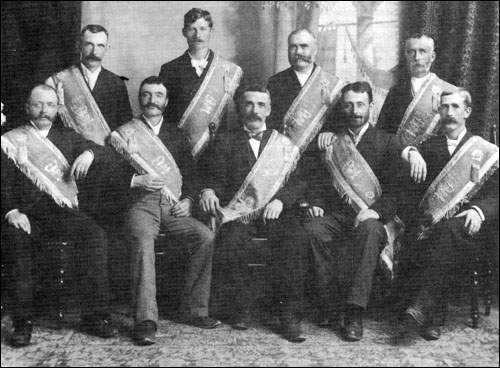Irish Fraternities in 19th Century St. John's: The Mechanics' Society
During the 19th century the cultural and social position of the Irish in Newfoundland society improved greatly. This was a result not only of the expansion of institutional Roman Catholicism, but of the development of male fraternal societies within a denominational and class context. These met the social, cultural and economic needs of the Irish portion of the population.
Outside the Benevolent Irish Society (B.I.S.), there were few existing fraternal organizations to which Irish Catholics in Newfoundland belonged. Bishop Fleming prohibited his congregations from becoming Freemasons, so unless one was a gentleman of some means and could become a member of the BIS, or a professional, the working class remained excluded from formal fraternal organizations.
One of the earliest trade organizations to be established was the Mechanics' Society, organized in March 1827. Not to be confused with the Church of England-sponsored Mechanics' Institute, the Mechanics' Society was established in the Irish-Newfoundland community as a self-help and educational society by four skilled tradesmen - Patrick Kelly, Edmond Power, Louis Martin, and William Walsh. Initial membership dues were the sum of 18 shillings as well as monthly dues of one shilling. The Society provided a meeting place and educational opportunities for its members, and, principally, a sickness insurance scheme, and a program of benefits for injured members or the families of deceased members.
Many of the early members of the Mechanics' Society were Irish Catholics from St. John's, but intra-Irish county origins, and membership in Irish factions such as the "Yellowbellies" or "Wheybellies" may also have played a part in determining its membership, as, usually, did social class.

Courtesy of The Rooms Provincial Archives Division (NF 57-20), St. John's, NL.
Like the Benevolent Irish Society, the rules of the Mechanics' Society prohibited members from formally discussing political or religious questions, but the Society occasionally took a public political stand. In 1829 it participated in a large parade through St. John's to celebrate Roman Catholic emancipation. Many of its early leaders became prominent in political life. The society's first two presidents - the cooper Lawrence Barron and the government carpenter and builder Patrick Kough - were from County Wexford families resident in Newfoundland for some time. Both men were denounced as "Yellowbellies" or "Mad Dogs" by the largely County Waterford-dominated political party led by reformers John Kent and William Carson (who had been defeated by Kough in the election of 1832), and by outspoken Catholic priests such as Edward Troy. In 1830, three years after he became the society's patron, Bishop Fleming resigned. At the same time, Fleming dismissed Kough from the Catholic Chapel's management committee, and the BIS Orphan Asylum committee on the grounds that Kough had opposed the Church and was a Freemason. However, all seems to have been forgiven by May 1841, when the Mechanics' Society marched in the parade which preceded the laying of the cornerstone of the Roman Catholic cathedral in St. John's.
Within 10 years of its founding the society was sufficiently well-financed to construct a meeting place called the Mechanics Hall (near the site of the present-day War Memorial on Duckworth Street). In 1892 this building was destroyed in the Great Fire. Although rebuilt, by 1895 the society was experiencing financial difficulties and losing its vitality and purpose. In the early 1900s the building became a theatre, and during 1960s and 70s a nightclub. It was torn down in the mid-80s. The Mechanics Society, itself, seems to have been disbanded soon after celebrating its 100th anniversary in 1927.




